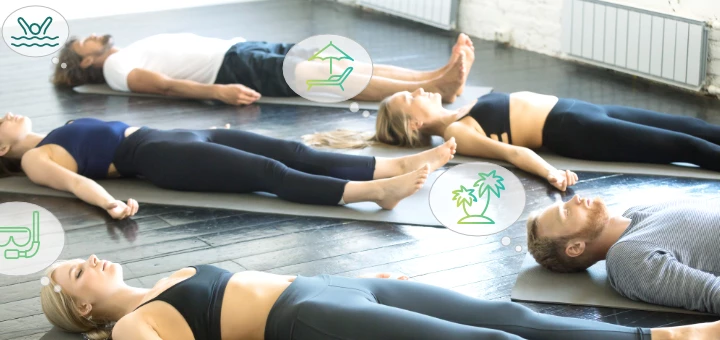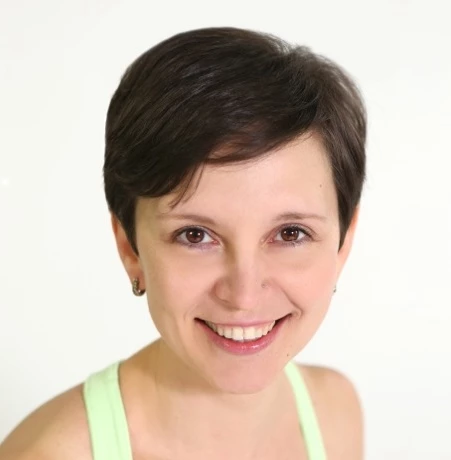Yoga Visualizations: How Our Brains Visualize and How to Create Safe Space for Students

Our brains store huge amounts of information that need to be kept organized and ready so that we can pull it up quickly. The brain keeps this information organized in categories, similar to how you keep your computer files in folders. This is called “categorization” and this is how your brain sorts all information.
For example, you have a “folder” in your head that stores all instances of “dog” you ever encountered. So if I asked you to think of a dog, your brain would probably pull up an image of a dog you saw recently or a breed of dog you like. This is called “the winning instance”—the image that gets pulled up out of thousands of other similar images from the same category.
Here is a remarkable thing: If you own a dog and adore it, your brain would conjure an image of your dog with a feeling of love mixed in (or what it feels like to hold it, to look at it, to play with it). If you want a dog but cannot have one right now, your brain would pull up the image of the puppy you saw in the pet store with a feeling of longing mixed in (of what it felt like to look at that puppy and want it, but not being able to take it home). On the other hand, if you were recently bitten by a dog, your brain would pull up the image of that dog and the feeling of fear you had when it happened.
Yoga Visualizations are as Individual as Your Students
The entire technique of visualization is based on that ability of the brain to pull up images tightly intertwined with your emotional-physiological responses to those images. But, of course, the tricky thing is that when you guide your students in yoga visualizations, you never know what kind of associations your students will have with those images.
Imagining a beach would be relaxing for most students, but if you recently got a bad sunburn on the beach, your brain will pull up that instance and will interlace the image of the beach with how it felt to have a sunburn—not so relaxing. Or if you ask your students to imagine as if they were floating on water to facilitate a feeling of lightness and buoyancy, but one of them had a near-drowning experience at some point in the past, the feelings that come up for them would be the opposite of buoyancy and relaxation.

How to Navigate Possible Triggers
Ultimately, we have no idea how individual students will respond to specific images. Because of that, it is best to warn your students ahead of time of what you are planning to do (as in, “We will do some imaginary floating later on. Is anybody uncomfortable with that?”). Or give them an opportunity to opt out (“If the image doesn’t work for you, just focus on your breath”).
It is also best to stick to more neutral images that are less likely to be jarring for the brain. I remember during my teacher training program one of the lead teachers was instructing us on visualization. She asked us to envision this big beautiful orange—imagine holding it in the hand, smelling it, and so on. And then she said: “Now take a nice little knife and cut it in half.”
Now, I don’t have any specific experiences with violence involving knives, but even I was jolted out of my relaxed state by that image. Simply introducing an object like a knife into such a receptive state was jarring for my brain and set off the alarm bells. Other teachers were even more upset afterward. Although it was simply an oversight on the part of the teacher, nevertheless I learned a lasting lesson from that exercise: be mindful of the images you introduce into your students’ consciousness.
Balancing Energy with Yoga
Our brains are constantly pulling up images of the world that are interlaced with our own emotional-physiological experiences, so we end up living in the world of our own making. This is why some scientists argue that there is no such thing as rational thought because no thought exists outside of the person’s brain. This means that every thought you have is loaded with meaning that comes from your inner state while you are having that thought.
“The bottom line is this: the human brain is anatomically structured so that no decision or action can be free of interoception [inner sensations] and affect [basic feelings], no matter what fiction people tell themselves about how rational they are. Your bodily feeling right now will project forward to influence what you will feel and do in the future. It is an elegantly orchestrated, self-fulfilling prophecy, embodied within the architecture of your brain.”(1)
If all our thoughts and actions stem from our inner sensations and basic feelings, it means that creating a balanced internal environment would result in a more balanced clear-eyed outlook on life. No wonder yogis were mostly concerned with balancing their energy and physiology!
Insightful yoga practice tips in a course by Olga Kabel and YogaUOnline – Yoga for Every Body: How to Adapt Yoga Poses for Different Situations, Conditions, and Purposes.
Reprinted with permission from Sequence Wiz.
 Educated as a school teacher, Olga Kabel has been teaching yoga for over 14 years. She completed multiple Yoga Teacher Training Programs but discovered the strongest connection to the Krishnamacharya/ T.K.V. Desikachar lineage. She had studied with Gary Kraftsow and American Viniyoga Institute (2004-2006) and received her Viniyoga Teacher diploma in July 2006 becoming an AVI-certified Yoga Therapist in April 2011. Olga is a founder and managing director of Sequence Wiz- a web-based yoga sequence builder that assists yoga teachers and yoga therapists in creating and organizing yoga practices. It also features simple, informational articles on how to sequence yoga practices for maximum effectiveness. Olga strongly believes in the healing power of this ancient discipline on every level: physical, psychological, and spiritual. She strives to make yoga practices accessible to students of any age, physical ability and medical history specializing in helping her students relieve muscle aches and pains, manage stress and anxiety, and develop mental focus.
Educated as a school teacher, Olga Kabel has been teaching yoga for over 14 years. She completed multiple Yoga Teacher Training Programs but discovered the strongest connection to the Krishnamacharya/ T.K.V. Desikachar lineage. She had studied with Gary Kraftsow and American Viniyoga Institute (2004-2006) and received her Viniyoga Teacher diploma in July 2006 becoming an AVI-certified Yoga Therapist in April 2011. Olga is a founder and managing director of Sequence Wiz- a web-based yoga sequence builder that assists yoga teachers and yoga therapists in creating and organizing yoga practices. It also features simple, informational articles on how to sequence yoga practices for maximum effectiveness. Olga strongly believes in the healing power of this ancient discipline on every level: physical, psychological, and spiritual. She strives to make yoga practices accessible to students of any age, physical ability and medical history specializing in helping her students relieve muscle aches and pains, manage stress and anxiety, and develop mental focus.
References
1. How Emotions Are Made: The Secret Life of the Brain by Lisa Feldman Barrett



